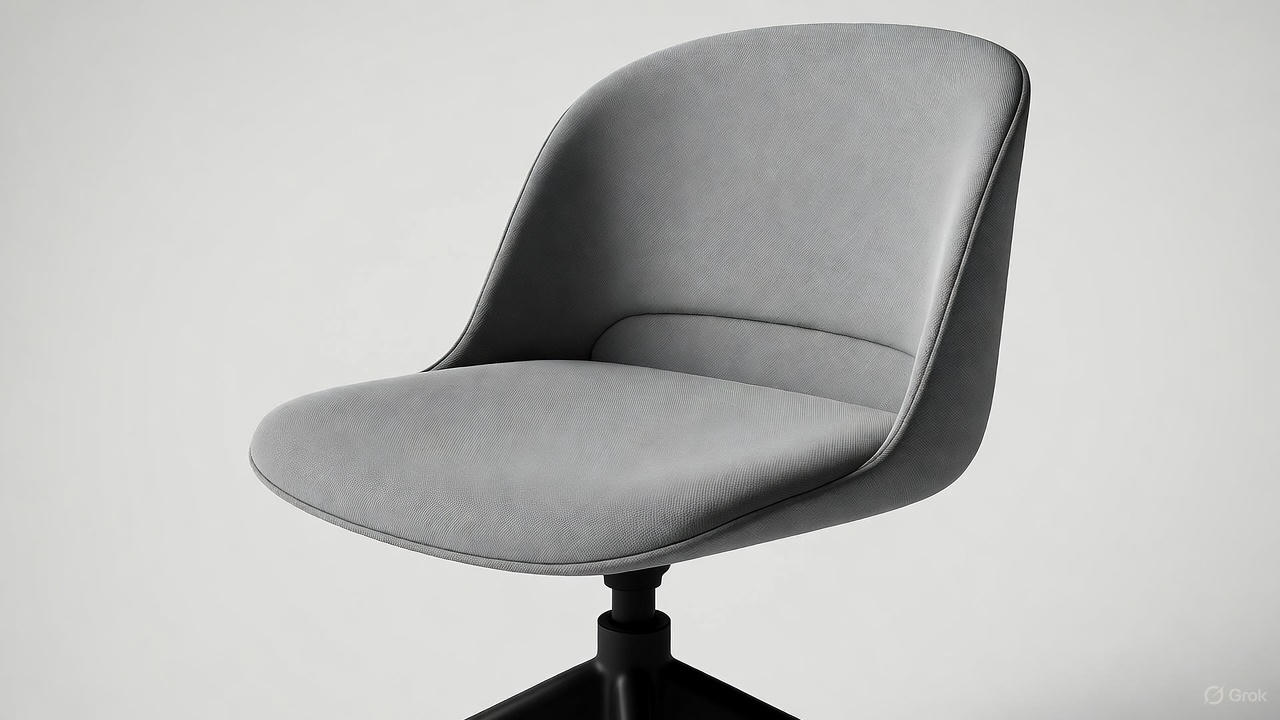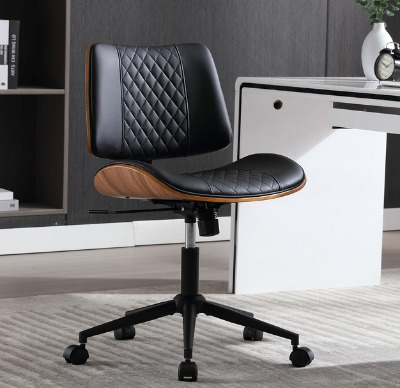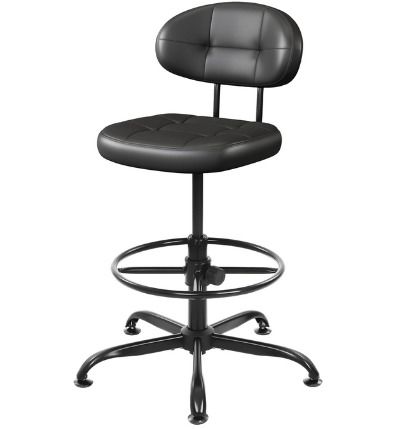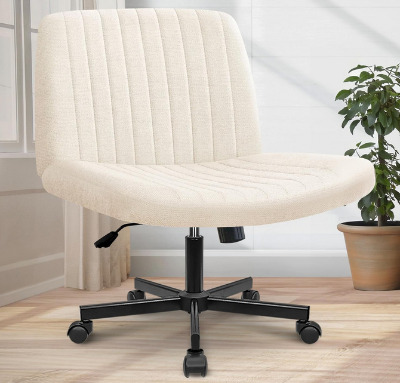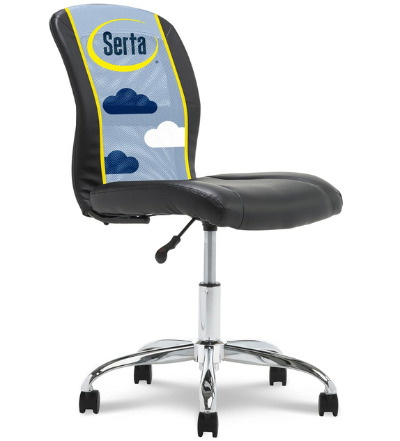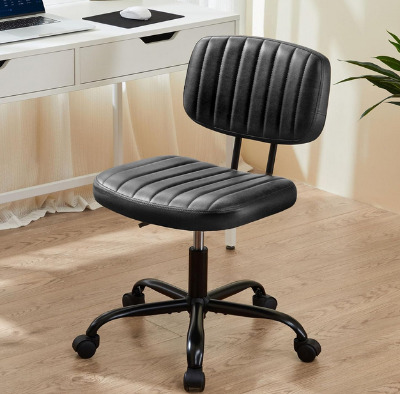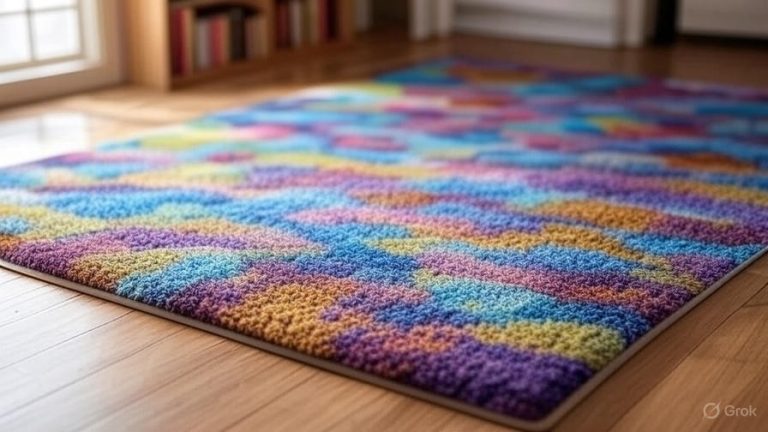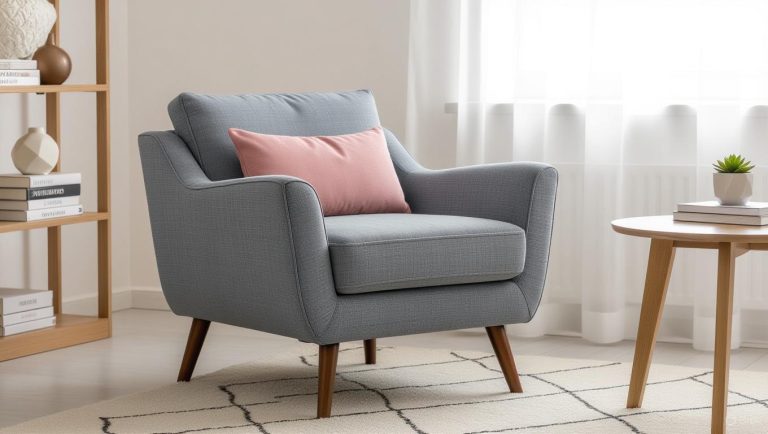5 Best Armless Desk Chair In 2025
Finding the perfect armless desk chair can transform your workspace into a more functional and comfortable environment. These compact seating solutions offer flexibility, space-saving design, and freedom of movement that traditional office chairs can’t match. This comprehensive review explores the top armless desk chairs available today, helping you make an informed decision for your home office, studio apartment, or professional workspace.
Why Armless Desk Chairs Are Gaining Popularity
The modern workspace demands versatility and efficiency. Armless office chairs have become increasingly popular among remote workers, creative professionals, and anyone seeking a minimalist approach to their workspace setup. These chairs eliminate the bulky armrests that can restrict movement and take up valuable space.
Space-conscious individuals particularly appreciate how armless chairs slide completely under desks, creating a cleaner aesthetic when not in use. This feature proves invaluable in small apartments, shared workspaces, or multi-purpose rooms where every square foot matters. The streamlined design allows you to move freely without bumping into armrests, making it easier to reach different areas of your desk or transition between tasks.
Ergonomic benefits also play a significant role in their rising popularity. Without armrests, you can sit closer to your desk, promoting better posture and reducing strain on your shoulders and neck. This positioning encourages a more natural typing position and reduces the temptation to slouch or lean awkwardly against armrests that might not be properly adjusted.
Key Features to Look for in an Armless Office Chair
Before diving into specific product reviews, understanding the essential features of quality armless seating helps you identify the best option for your needs. These characteristics separate exceptional chairs from mediocre alternatives and directly impact your daily comfort and productivity.
Adjustable Height Mechanism
A reliable height adjustment system stands as the foundation of any quality desk chair. Look for pneumatic gas lift cylinders that provide smooth, effortless adjustments. The height range should accommodate your desk height and leg length, allowing your feet to rest flat on the floor with your thighs parallel to the ground. Quality mechanisms maintain their settings without gradual sinking throughout the day, which cheaper alternatives often fail to do.
Seat Cushioning and Material
The seat cushion determines your comfort during long working sessions. High-density foam maintains its shape and support over time, while low-quality foam compresses and becomes uncomfortable within months. The covering material affects both comfort and durability. PU leather offers easy cleaning and a professional appearance, fabric provides breathability, and genuine leather delivers premium comfort with proper maintenance.
Swivel and Mobility Features
A 360-degree swivel function enables you to access different workspace areas without straining. If your chair includes wheels, check the caster quality and floor compatibility. Hard plastic wheels work best on carpeted surfaces, while rubberized or soft wheels protect hardwood and tile floors from scratches. Some armless chairs feature stationary bases, which provide stability at standing desks or vanity tables.
Back Support Design
Even without arms, proper back support remains crucial. Mid-back chairs support the lumbar region and lower back, suitable for most desk work. High-back designs offer additional upper back and shoulder support for longer sessions. Mesh backs promote airflow and prevent heat buildup, while padded backs provide cushioned comfort. The backrest should follow your spine’s natural curve and offer some flexibility to accommodate movement.
Weight Capacity and Build Quality
Check the manufacturer’s weight rating to ensure the chair can safely support your body type. Quality construction uses sturdy materials like reinforced plastic, metal frames, or wood components. Wobbly or unstable bases indicate poor manufacturing and potential safety issues. The overall build quality affects longevity, with well-constructed chairs lasting several years of daily use.
Top 5 Armless Desk Chairs Reviewed
After extensive research and analysis, these five armless desk chairs stand out for their quality, functionality, and value. Each offers unique features suited to different needs and preferences.
1. Home Office Chair No Arms with Wheels – Best Overall Value
This PU leather mid-back chair combines professional aesthetics with practical functionality. The walnut wood base adds a sophisticated touch that elevates any workspace, departing from the typical all-black office chair design. The combination of materials creates visual interest while maintaining a cohesive, modern look.
The adjustable height mechanism operates smoothly through a wide range, accommodating users from approximately 5’2″ to 6’2″ comfortably. The pneumatic gas lift maintains its position reliably throughout extended use. Five smooth-rolling casters provide excellent mobility across various floor types without requiring excessive effort to move around.
The mid-back design offers substantial lumbar support without feeling restrictive. The PU leather covering resists spills and stains, making it ideal for busy home offices where coffee and snacks are common companions. The cushioning strikes a good balance between soft comfort and firm support, preventing the sinking feeling that plagues poorly made chairs.
The 360-degree swivel function works effortlessly, allowing quick transitions between different work areas. The chair assembles relatively quickly, with clear instructions and all necessary tools included. Most users complete assembly in 20-30 minutes without frustration.
At its price point, this chair delivers exceptional value. The walnut wood base provides a premium appearance typically found on more expensive models. The build quality feels solid, with no wobbling or concerning creaks during normal use. This chair suits professionals who want a stylish, functional seating solution without breaking their budget.
The compact design fits easily under most standard desks, making it perfect for small spaces. The absence of arms allows unrestricted movement, particularly beneficial for those who frequently reach across their desk or use multiple monitors. The chair’s aesthetic versatility means it works equally well in traditional offices, contemporary home studios, or cozy reading nooks.
2. Misolant Armless Drafting Chair – Best for Standing Desks
Standing desk users face unique challenges when seeking seating options, and this tall drafting chair addresses those needs specifically. The elevated height range accommodates standing desk positions that would leave standard chairs too low for comfortable use. The adjustable foot ring provides crucial leg support at higher positions, reducing strain on your thighs and improving circulation.
The faux leather upholstery combines durability with easy maintenance. Spills wipe away quickly, and the material resists cracking or peeling that cheaper vinyl alternatives suffer. The black finish maintains a professional appearance that complements most office decor schemes. The padding density provides comfortable support during extended sitting periods without becoming overly soft.
This chair features a stationary base without wheels, offering rock-solid stability. This design choice makes perfect sense for standing desk applications where you need consistent positioning and no risk of rolling. The base width provides ample stability without taking up excessive floor space. The stationary design also works beautifully at bar counters, vanity tables, or drafting tables where mobility isn’t required.
The backrest offers executive-style support despite the compact footprint. The curved design follows natural spine contours, promoting healthy posture even during long work sessions. The backrest height and angle support both upright typing positions and slightly reclined thinking postures.
Assembly proves straightforward, with most users completing the process in under 30 minutes. The instructions clearly illustrate each step, and the included hex key fits properly without stripping the screws. The quality control appears consistent, with minimal reports of missing parts or manufacturing defects.
This chair shines brightest for those with adjustable standing desks who want a perching option for breaks from standing. The foot ring becomes invaluable when the seat reaches higher positions, providing a comfortable place to rest your feet. The tall design also makes this an excellent choice for higher-than-average desks or counter-height workstations.
The small footprint makes this drafting chair ideal for compact workspaces where floor space comes at a premium. Despite the higher seat position, the chair remains stable during use, with no tipping concerns during normal sitting and standing transitions. The executive styling elevates the visual appeal beyond typical utilitarian drafting stools.
3. Orange Factory Criss Cross Chair – Best for Comfort and Style
This innovative chair breaks the mold of traditional office seating with its unique cross-legged design option. The wide, fabric-covered seat accommodates various sitting positions, from traditional to casual cross-legged postures. This flexibility proves particularly valuable during long working days when changing positions helps reduce fatigue and maintain focus.
The beige fabric covering brings warmth and texture to your workspace, creating a more inviting atmosphere than stark black plastic or leather. The fabric breathes well, preventing the heat buildup and stickiness that can plague non-breathable materials during warm weather. The neutral tone coordinates beautifully with various color schemes and design styles, from Scandinavian minimalism to bohemian eclecticism.
The seat width exceeds standard office chairs, providing room to shift positions or tuck one leg underneath you comfortably. This extra space accommodates different body types without feeling cramped. The cushioning uses quality foam that maintains its shape and support through daily use, avoiding the flat, uncomfortable feel of cheap padding.
The smooth-rolling wheels glide effortlessly across hardwood, tile, and low-pile carpet. The casters appear durable and well-constructed, showing little wear even after extended use. The 360-degree swivel operates smoothly without resistance or noise, making it easy to access different areas of your workspace.
The backrest provides gentle support without being overly structured. This relaxed approach suits the chair’s flexible, comfort-focused design philosophy. The back height supports your lower and mid-back while allowing freedom of movement for your shoulders and arms.
Assembly takes minimal time and requires no special tools. The straightforward design means fewer parts to connect, reducing the chance of errors. The build quality feels substantial, with sturdy components that inspire confidence in the chair’s longevity.
This chair excels for creative professionals, casual home offices, or anyone who values comfort and personality in their workspace. The ability to sit cross-legged provides a welcome alternative to rigid, formal seating positions. This posture can actually improve focus and comfort for many people, particularly during brainstorming sessions or reading tasks.
The unique design makes a statement without being loud or distracting. It signals a workspace that values comfort and individuality alongside productivity. The fabric covering adds a softer, more residential feel compared to clinical office furniture, making it perfect for home offices that double as living spaces.
4. Serta Essential Armless Task Chair – Best Breathable Option
Serta’s reputation for quality seating translates beautifully to this armless task chair. The combination of breathable mesh backing and faux leather seat creates an ideal balance of airflow and comfort. The mesh back prevents the heat buildup that makes long sitting sessions uncomfortable, keeping your back cool and dry throughout the workday.
The mesh material flexes slightly as you move, providing dynamic support that adapts to your posture changes. This flexibility feels more natural than rigid plastic backs, reducing pressure points and improving comfort. The mesh remains taut and supportive, showing no signs of sagging or stretching that can affect cheaper mesh chairs over time.
The faux leather seat offers easy cleaning and maintenance while providing a smooth, comfortable sitting surface. The cushioning uses quality foam that maintains its supportive properties without becoming too firm or too soft. The seat edge features gentle contouring that reduces pressure on the backs of your thighs, promoting better circulation.
The wheel configuration provides excellent mobility without sacrificing stability. The casters roll smoothly across various surfaces, making it easy to move around your workspace or pull up to different work areas. The chair remains stable during use, with no unwanted rolling or movement when you don’t intend to move.
The minimalist design philosophy shines through in every aspect of this chair. Clean lines and understated styling ensure the chair complements rather than dominates your workspace. This aesthetic versatility makes it suitable for professional offices, creative studios, bedroom workspaces, or vanity areas.
The adjustable height mechanism operates smoothly through a practical range suitable for most desk heights and user heights. The gas lift maintains its position reliably without gradual sinking, a common problem with budget office chairs. The adjustment lever positions conveniently for easy reach without requiring awkward contortions.
Assembly follows Serta’s typically straightforward approach, with clear instructions and quality hardware. Most users complete the process quickly without frustration. The components fit together precisely, indicating good quality control during manufacturing.
This chair particularly suits hot climates or naturally warm individuals who struggle with heat retention in traditional padded office chairs. The mesh back promotes airflow that keeps you comfortable during marathon work sessions. The design also appeals to those seeking a clean, minimal aesthetic that doesn’t sacrifice functionality.
The compact footprint makes this chair perfect for small offices, apartments, or shared workspaces where space efficiency matters. Despite the streamlined design, the chair feels sturdy and substantial during use. The quality construction suggests this chair will provide reliable service for several years of regular use.
5. Sweetcrispy Small Office Desk Chair – Best Budget-Friendly Option
This compact rolling chair delivers impressive functionality at an accessible price point. The PU leather covering provides a professional appearance and easy maintenance without the premium cost of genuine leather. The material resists basic wear and minor spills, making it practical for daily use in busy home offices.
The built-in lumbar support sets this budget chair apart from similar price-point competitors. The gentle curve in the lower backrest promotes healthy posture by supporting your spine’s natural alignment. This feature typically appears only on more expensive models, making its inclusion here particularly valuable.
The low-back design creates an open, unrestricted feeling while still providing essential support. This style works well for those who prefer minimal back contact or want maximum freedom of movement. The back height suits shorter users particularly well, providing support without forcing an uncomfortable upright position.
The smooth-rolling wheels maneuver easily across hard floors and thin carpets. The 360-degree swivel function operates without resistance, allowing effortless transitions between tasks or workspace areas. The caster quality appears adequate for the price point, though they may not match the durability of premium models over extended use.
The height adjustment range accommodates most standard desk heights and user heights. The pneumatic mechanism operates reliably, though the adjustment lever requires slightly more force than premium alternatives. The chair maintains its height setting without noticeable sinking during normal use.
Assembly proves quick and simple, with most users completing the process in 15-20 minutes. The instructions provide clear visual guides, and all necessary hardware comes included. The components fit together properly, indicating reasonable quality control standards.
The compact dimensions make this chair ideal for small spaces where full-size office chairs feel overwhelming. The chair slides easily under most desks, creating a tidy appearance when not in use. This space efficiency proves particularly valuable in studio apartments, small bedrooms, or shared workspaces.
The build quality meets reasonable expectations for the price category. While it doesn’t match the robust construction of premium models, the chair feels stable and functional during normal use. With reasonable care, this chair should provide reliable service for budget-conscious users.
This chair serves students, occasional work-from-home situations, spare bedrooms, or secondary workspaces exceptionally well. The combination of essential features and affordable pricing makes it accessible to those who need functional seating without major investment. The professional appearance belies the modest price point, creating an impression of quality.
The lumbar support feature makes this chair punch above its weight class in terms of ergonomic value. Rather than sacrificing comfort for cost savings, Sweetcrispy included thoughtful design elements that improve daily use. This attention to user needs makes the chair feel more expensive than its actual price suggests.
How to Choose the Right Armless Chair for Your Workspace
Selecting the perfect armless desk chair requires consideration of your specific needs, workspace constraints, and usage patterns. These factors guide you toward the option that will serve you best in daily use.
Assess Your Space Requirements
Measure your workspace carefully before committing to a chair purchase. Note the distance between your desk and any walls, filing cabinets, or other furniture. Consider how much clearance you need for the chair to swivel and roll freely. For small spaces, prioritize compact designs that tuck completely under your desk when not in use.
Ceiling height matters for tall users or those considering drafting chairs for standing desks. Ensure adequate headroom when the chair reaches its maximum height adjustment. Room layout also influences your choice – open floor plans accommodate mobile chairs with wheels, while tight spaces might benefit from stationary models.
Consider Your Work Style
Your daily activities significantly impact which chair features matter most. If you frequently reach across your desk or work with multiple monitors, prioritize chairs with excellent swivel functions and mobility. Those who sit for extended periods should emphasize cushioning quality and back support over other features.
Creative professionals who shift between focused work and brainstorming might appreciate chairs that accommodate various sitting positions. Traditional office workers may prefer structured support that promotes consistent posture. Physical jobs that involve frequent standing and sitting benefit from quick height adjustments and durable construction.
Evaluate Your Desk Height
Standard desk heights range from 28 to 30 inches, while standing desks adjust from approximately 25 to 50 inches. Match your chair’s height range to your desk configuration. Standard office chairs work well with traditional desks, while drafting chairs suit standing desk users or higher work surfaces.
Test the height range if possible before purchasing. When properly adjusted, your feet should rest flat on the floor with your thighs parallel to the ground. Your elbows should form 90-degree angles when your hands rest on the keyboard. This positioning reduces strain on your back, shoulders, and wrists.
Think About Aesthetic Preferences
Your chair contributes significantly to your workspace’s overall look and feel. Consider how different materials, colors, and styles harmonize with your existing decor. Modern workspaces often suit sleek, minimalist designs with clean lines. Traditional offices might benefit from wood accents or classic styling.
Personal preference plays a legitimate role here – you’ll use this chair daily, so it should appeal to your aesthetic sensibilities. A chair you find visually pleasing creates a more enjoyable workspace environment. However, don’t sacrifice functionality for appearance; the best choice balances both considerations.
Budget Considerations
Determine your budget before shopping to narrow your options effectively. Quality armless chairs range from under $100 to several hundred dollars. Higher prices generally correlate with better materials, superior construction, and enhanced durability. However, several budget-friendly options deliver excellent value for their price point.
Consider the chair as a long-term investment in your comfort and productivity. A quality chair that lasts several years costs less over time than repeatedly replacing cheap alternatives. That said, occasional users or secondary workspaces don’t necessarily require premium models. Match your investment to your usage frequency.
Armless vs. Traditional Office Chairs: Making the Comparison
Understanding the tradeoffs between armless and traditional office chairs helps you make an informed decision based on your priorities and needs.
Space Efficiency
Armless chairs excel in compact environments. The lack of arms reduces the overall footprint by several inches on each side, creating valuable breathing room in tight spaces. These chairs slide completely under desks, creating clean sight lines and maximizing floor space when not in use. This advantage proves particularly significant in small apartments, shared offices, or multi-purpose rooms.
Traditional chairs with arms require more clearance on both sides and cannot tuck under standard desks completely. The armrests often catch on desk edges or other furniture, limiting placement options. In spacious offices, this difference matters less. In constrained spaces, armless designs provide clear advantages.
Freedom of Movement
Without armrests blocking lateral movement, armless chairs allow unrestricted side-to-side motion. This freedom benefits activities that require reaching across your desk, working with materials on either side, or frequently changing focus between multiple work areas. Musicians, artists, and crafters particularly appreciate this flexibility.
Traditional chairs with arms can restrict movement and create awkward positions when reaching beyond the armrest boundaries. The arms may bump against desk edges when rolling forward, preventing optimal positioning. However, armrests provide support during typing breaks and make sitting down or standing up easier for some users.
Posture and Ergonomics
Armless chairs encourage sitting closer to your desk, promoting better typing posture with elbows at your sides. This positioning reduces shoulder strain and encourages neutral wrist angles. The absence of armrests eliminates the temptation to lean awkwardly or prop yourself at uncomfortable angles.
Traditional chairs with properly adjusted armrests can support your forearms during typing, reducing shoulder fatigue. However, poorly adjusted or poorly designed armrests often cause more harm than good, forcing awkward postures or preventing proper desk proximity. Many users never properly adjust their armrests, negating potential benefits.
Versatility
Armless chairs adapt easily to various uses beyond desk work. They function well at vanity tables, craft areas, dining tables, or anywhere you need flexible seating. The clean design transitions between different spaces and purposes without looking out of place.
Traditional office chairs with arms look decidedly office-specific and may appear awkward in residential settings or multipurpose rooms. The specialized appearance limits their versatility, though they remain ideal for traditional office environments.
Maintenance Tips for Long-Lasting Performance
Proper care extends your chair’s lifespan and maintains optimal performance. These straightforward maintenance practices require minimal time but deliver significant benefits.
Regular Cleaning
Clean your chair’s surfaces regularly to prevent dirt buildup and material degradation. For PU leather or faux leather, wipe down with a damp cloth weekly and use mild soap for stubborn spots. Avoid harsh chemicals that can crack or discolor the material. Fabric chairs benefit from regular vacuuming and occasional spot cleaning with upholstery cleaner.
Mesh backs require minimal maintenance – simply vacuum or wipe with a damp cloth to remove dust and debris. Pay attention to crevices where dust accumulates, as this buildup can affect the chair’s appearance and hygiene. Clean spills immediately to prevent staining, particularly on fabric or light-colored materials.
Wheel Maintenance
Chair wheels accumulate hair, dust, and debris that can impair smooth rolling. Flip the chair and remove buildup from each caster every few months. Use scissors to cut away wound hair and wipe away accumulated grime. This simple maintenance prevents sticky, difficult-to-roll wheels that strain your effort and patience.
Check wheel attachment points periodically to ensure they remain secure. Tighten any loose wheels promptly to prevent uneven rolling or potential detachment. If wheels show significant wear or develop flat spots, replacement casters are generally inexpensive and easy to install.
Mechanism Lubrication
The height adjustment mechanism benefits from occasional lubrication. If the pneumatic lift becomes difficult to activate or makes squeaking sounds, apply a small amount of silicone spray to the cylinder shaft. Wipe away excess to prevent attracting dirt. This simple maintenance restores smooth operation and extends mechanism lifespan.
Swivel mechanisms rarely require maintenance, but occasional squeaking indicates needed lubrication. Apply a tiny amount of light oil to the swivel point, then rotate the chair several times to distribute the lubricant. Avoid over-lubricating, as excess oil can drip onto flooring.
Cushion Care
Rotate your sitting position slightly throughout the day to distribute wear across the seat cushion evenly. This practice prevents permanent indentations in specific spots. Fluff cushions periodically if your chair features removable padding. For chairs with fixed cushioning, simply ensure you don’t always sit in exactly the same position.
Avoid standing on chairs or placing excessive weight on seats, as this can compress foam beyond its elastic limits. These practices cause premature flattening and reduce comfort. Use your chair as intended to maximize its lifespan.
Tightening Connections
Check all screws, bolts, and connection points every few months. Regular use can gradually loosen these fasteners, affecting stability and safety. Tighten any loose connections promptly using the appropriate tools. This preventive maintenance takes just a few minutes but prevents wobbling and potential structural failure.
Pay particular attention to the connection between the seat and the pneumatic cylinder, as this joint handles significant stress. The backrest attachment points also deserve regular inspection. These simple checks prevent small issues from becoming major problems.
Common Issues and Solutions
Even quality chairs occasionally present challenges. Understanding common problems and their solutions helps you maintain optimal performance.
Sinking Seat Height
If your chair gradually loses height during use, the pneumatic gas cylinder likely needs replacement. This common issue affects chairs across all price points eventually. Replacement cylinders cost $20-40 and install relatively easily with basic tools. Many online tutorials guide you through the process step-by-step.
Before replacing the cylinder, ensure the height adjustment lever fully returns to its locked position. Sometimes partial engagement allows slow sinking. Clean the lever mechanism and ensure nothing obstructs its full range of motion.
Difficult Rolling
Sticky, hard-to-roll wheels usually indicate debris buildup in the casters. Remove the chair from your workspace and flip it over. Cut away wound hair and wipe accumulated dirt from each wheel. This simple maintenance often completely resolves rolling issues.
If cleaning doesn’t help, check your flooring type against the wheel type. Hard plastic wheels struggle on hard floors, while soft wheels resist rolling on thick carpet. Replacing wheels with appropriate types for your flooring solves this mismatch. Replacement casters are inexpensive and widely available.
Squeaking Noises
Squeaks typically originate from the swivel mechanism, height adjustment cylinder, or connections between components. Identify the source by systematically testing each movement – rotating, adjusting height, and rocking in different directions. Apply appropriate lubricant to the problematic area.
For persistent squeaks from connection points, try tightening all screws and bolts. Loose connections often create noise during movement. If squeaking continues after lubrication and tightening, consider placing felt pads or rubber washers between metal components to dampen vibrations.
Uneven Rolling
Chairs that roll in one direction or feel unstable usually have one or more damaged wheels. Inspect each caster for flat spots, cracks, or excessive wear. Replace any damaged wheels promptly to restore stable, predictable rolling. Uneven wheel wear often indicates rolling primarily in one direction – rotating your workspace layout occasionally promotes more even wear.
Check the wheel attachment points as well. Loose wheels cause uneven rolling and potential safety hazards. Tighten all caster connections and ensure they’re properly seated in their sockets.
Cushion Flattening
Over time, seat cushions naturally compress and lose their initial firmness. High-quality foam resists this longer, but all cushioning eventually shows wear. If flattening becomes uncomfortable before you’re ready to replace the chair, consider adding a seat cushion or pad. These accessories restore comfort and extend the chair’s useful life.
Prevent premature flattening by avoiding standing on chairs and distributing your weight evenly during sitting. These practices maximize cushion longevity and delay the need for replacement or supplementation.
Setting Up Your Armless Chair for Maximum Comfort
Proper setup transforms even basic chairs into comfortable workstations. These adjustments optimize ergonomics and reduce fatigue during extended use.
Height Adjustment
Start by setting the seat height so your feet rest flat on the floor with thighs parallel to the ground. Your knees should form approximately 90-degree angles, with slight clearance between the seat front edge and the backs of your knees. This positioning promotes healthy circulation and reduces leg strain.
When seated at your desk, your elbows should form 90-degree angles with forearms parallel to the floor while typing. If this proves difficult to achieve simultaneously with proper leg positioning, adjust your desk height if possible or use a footrest to fine-tune your positioning.
Monitor Positioning
Place your monitor directly in front of you at arm’s length distance. The screen’s top should align approximately with eye level, allowing you to view the display with a slightly downward gaze. This positioning reduces neck strain and encourages healthy posture. Avoid placing monitors to the side, as this forces sustained neck rotation that causes discomfort.
If using multiple monitors, position your primary display directly in front and secondary screens at slight angles. Ensure you can view all screens without extreme head movements. Laptop users should consider external monitors or laptop stands to achieve proper screen height.
Keyboard and Mouse Placement
Position your keyboard directly in front of you with the mouse alongside at the same level. Your keyboard should sit at a height where your elbows form 90-degree angles with forearms parallel to the floor or sloping slightly downward. This positioning reduces wrist strain and encourages neutral wrist angles.
Keep frequently used items within easy reach to minimize stretching and reaching. This includes your phone, notepad, and any tools or materials you access regularly. Reducing excessive reaching prevents strain and maintains focus on your work.
Lighting Considerations
Ensure adequate lighting that doesn’t create glare on your screen or cause eye strain. Position desk lamps to illuminate your workspace without reflecting directly off your monitor. Natural light should come from the side rather than directly behind or in front of you to prevent glare and harsh shadows.
Consider your chair position relative to windows during different times of day. Adjust window coverings or reposition your workspace if sunlight creates uncomfortable glare or heat during certain hours.
Break Reminders
Even the most comfortable chair doesn’t eliminate the need for regular movement. Set reminders to stand, stretch, and move every 30-60 minutes during extended work sessions. These breaks improve circulation, reduce fatigue, and actually enhance productivity by refreshing your focus.
Use breaks to adjust your sitting position, perform simple stretches, or walk briefly. These habits complement your ergonomic setup and protect your long-term health.
Conclusion: Finding Your Perfect Armless Desk Chair
The ideal armless desk chair balances comfort, functionality, and style to meet your specific needs. Each option reviewed here offers distinct advantages for different use cases and preferences. The Home Office Chair with walnut base delivers outstanding overall value with its attractive design and solid performance. The Misolant Drafting Chair serves standing desk users exceptionally well with its elevated height range and stability. The Orange Factory Criss Cross Chair provides unmatched comfort and sitting flexibility for those who value relaxed positioning.
The Serta Essential Task Chair offers superior breathability and minimal aesthetics for hot climates or streamlined spaces. The Sweetcrispy chair delivers impressive functionality for budget-conscious shoppers without sacrificing essential features. Your perfect choice depends on your workspace size, desk height, work style, aesthetic preferences, and budget constraints.
Take time to assess your specific requirements before purchasing. Consider how you work daily, what features matter most to your comfort, and how the chair will integrate into your existing workspace. Measure your space carefully and think through your typical work activities to identify which features will enhance your daily experience.
Remember that your chair significantly impacts your comfort, posture, and productivity during work hours. This investment deserves thoughtful consideration rather than impulse decisions. The right armless desk chair becomes an invisible tool that supports your work rather than a source of discomfort or distraction.
With proper selection, setup, and maintenance, a quality armless chair provides years of reliable, comfortable service. The space efficiency, freedom of movement, and clean aesthetics make these chairs increasingly popular across various work environments. Whether outfitting a home office, updating a professional workspace, or creating a study area, armless desk chairs offer practical solutions that don’t compromise on comfort or style.
Start by identifying your priorities among the features discussed in this guide. Then match those priorities to the chairs reviewed here. This methodical approach leads you to the option best suited to your individual needs, ensuring satisfaction with your purchase and enhanced comfort throughout your workday.

